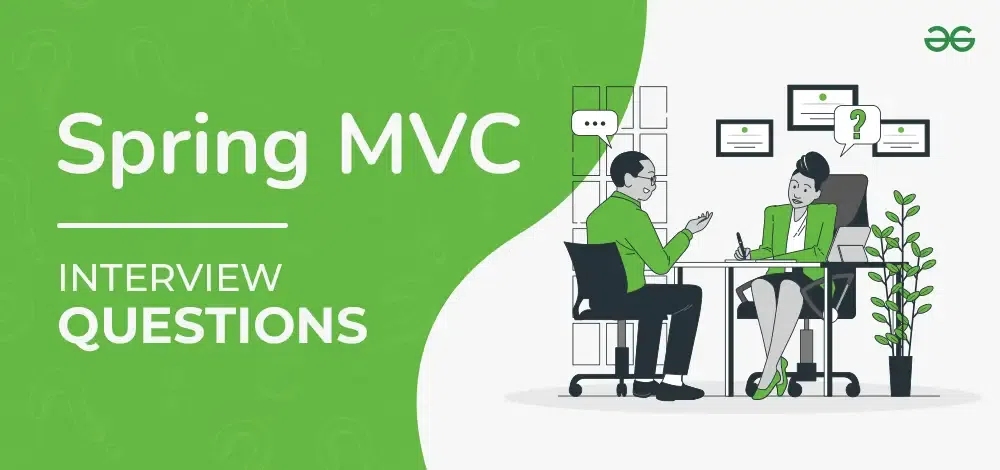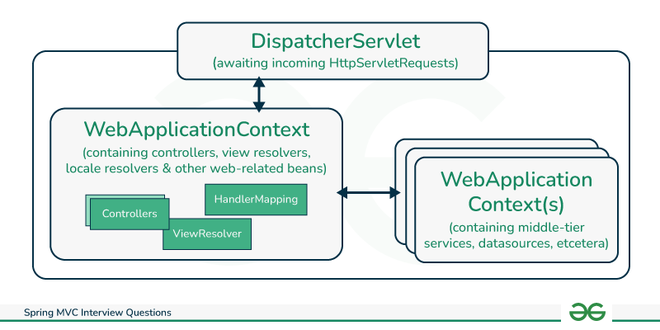
|
|
Spring MVC is a powerful framework used in Java for building web applications. It is known for its complete configuration options, seamless integration with other Java frameworks, and robust architecture. Many top companies, including Netflix, Amazon, Google, and Airbnb, rely on Spring MVC to build scalable and maintainable web applications due to its ease of use and flexibility. Here, we provide Top Spring MVC Interview Questions tailored for both Freshers and experienced professionals with 3, 5, and 8 years of experience. Here, we cover everything, including Spring MVC architecture, request handling, data binding, validation, exception handling, Spring Security, and more, that will surely help you to crack Spring MVC interviews.
Table of Content Spring MVC Interview Questions for Freshers1. What is MVC?MVC refers to Model, View, and Controller. It is an architectural design pattern, which governs the application’s whole architecture. It is a kind of design pattern used for solving larger architectural problems. MVC divides a software application into three parts that are:
2. What is Spring MVC?Spring MVC is a sub-framework of Spring framework which is used to build dynamic web applications and to perform Rapid Application Development (RAD).
3. Difference between Spring Boot and Spring MVC
Know more difference between Spring Boot and Spring MVC 4. Explain Spring MVC Architecture.Spring MVC Architectural Flow Diagram:
5. What are the Key Components of Spring MVC Architecture?Below are the Key Components of Spring MVC Architecture:
6. Explain the Model-View-Controller (MVC) Design Pattern.MVC design pattern is a way to organize the code in our application. MVC refers to Model, View, and Controller.
Below is the Model-View-Controller Flow diagram:
Know more about MVC design pattern 7. What is Dispatcher Servlet in Spring MVC?Dispatcher Servlet is the Front Controller in the Spring MVC framework. This is a class that receives the incoming HTTP requests and maps these requests to the appropriate resources such as model, controller, and view. Also, it sends the appropriate responses to the requests. Dispatcher Servlet manages the entire flow of an application. Know more about dispatcher servlet 8. Explain the five most used annotations in Spring MVC Project.The most used five annotations in the Spring MVC project are:
@Controller
@RestController
@GetMapping("/clients)
@GetMapping("/client/{clientName}")
@ModelAttribute("client") 9. What is ViewResolver in Spring MVC?In Spring MVC, ViewResolver is used to determine how a logical view name is received from a controller and maps that to an actual file. There are different types of ViewResolver classes. Some of them are defined below:
Know more about ViewResolver in Spring MVC 10. Difference between @Controller and @RestController
Know the difference between @Controller and @RestController 11. What is WebApplicationContext in Spring MVC?WebApplicationContext is an extension of ApplicationContext. It has servlet context information. We can use multiple WebApplicationContext in a single web application which means every dispatcher servlet is associated with a single WebApplicationContext. A web application can have more than one dispatcher servlet to handle HTTP requests and every front controller has a separate WebApplicationContext configuration file. It is configured using *-servlet.xml file.
12. What is DTO and Repository Interface in Spring MVC?DTO: DTO stands for Data Transfer Object. It is a simple model class that encapsulates other different objects into one. Sending the data between client and server requires a model class. When the client requests data from the server, instead of sending multiple responses it will send only one.
data class GfgAuthor ( Repository Interface: To establish database connectivity and data access, we define logic and methods inside the repository class, and we define this interface by putting @Repository annotation.
Watch this video on DTO in Spring MVC 13. How to handle different types of incoming HTTP request methods in Spring MVC?To handle different types of HTTP request methods we use @RequestMapping annotation in Spring MVC. For mapping incoming HTTP requests with the handler method at the method level or class level, @RequestMapping annotation is being used. @RequestMapping(value = "", method=RequestMapping.GET)
There are different types of methods for HTTP requests.
For each request,run we can use separate annotations like @GetMapping, @PostMapping, @PutMapping, and @DeleteMapping instead of passing the method inside the @RequestMapping annotation. Ex- @GetMapping("/hello")
14. Difference between ApplicationContext and WebApplicationContext in Spring MVC
Know the difference between ApplicationContext and WebApplicationContext Spring MVC Interview Questions for Intermediate(1+ years)15. How to perform Validation in Spring MVC?There are so many different ways to perform validation in Spring MVC.
public class GfgAuthor {
Know more about Spring MVC Validation 16. How to perform Exception Handling in Spring MVC?Exception means an unexpected error that occurs during application execution. To identify or handle that error, called Exception Handling. In Spring MVC, we can handle exceptions using many mechanisms, three of which are described below:
@ExceptionHandler(ResourceNotFound.class)
public class GfgExceptionHandler implements HandlerExceptionResolver
Know more about Spring MVC Exception handling 17. Difference between @RequestParam and @PathVariable annotations in Spring MVC
Know the difference between @RequestParam and @PathVariable annotation 18. Explain Query String and Query Parameter in Spring MVC.In Spring MVC, Query String and Query Parameter are used to pass the data to a web application through URL.
https://gfg.org?path?key=value&key1=value1
To access query parameters @RequestParam and @PathVariable annotations are used in a Spring MVC application. Read about Query String and Query Parameter in Spring MVC 19. Define the purpose of the @ModelAttribute annotation.@ModelAttribute in Spring MVC has many purposes but the two main purposes are defined below:
Know more about @ModelAttribute annotation 20. Difference between @RequestBody and @ResponseBody Annotation in Spring MVC
21. Explain the Multi Action Controller in Spring MVC.Multi Action Controller in Spring MVC is a unique controller class (MultiActionController) that is used to handle multiple HTTP request types like GET, PUT, POST ETC. There are many advantages of Multi Action Controller.
Spring MVC Interview Questions For Experienced(5+years)22. Explain Spring MVC Interceptor.Spring MVC Interceptor acts as a middleware in MVC applications. While executing the requests, we can process the requests also after, before or during the execution of the requests. We can make certain changes and can process the requests.
Know more about Interceptor 23. Explain the role/purpose of ContextLoaderListener in Spring MVC.ContextLoaderListener is an important module of Spring MVC. It initializes the Spring ApplicationContext. Some functionalities of ContextLoaderListener is:
24. How to enable CSRF protection in a Spring MVC Application?CSRF stands for Cross Site Request Forgery. It is a security vulnerability. In this, a hacker can hack end user’s browser and send requests to web applications which may cause sensitive data leaks and any unauthorized actions. CSRF protection is enabled by Spring Security for the web applications that are starting from the 4.0 version. Steps to follow for enabling CSRF in Web Applications:
Know more about enable and disable CSRF 25. How to use JSTL with Spring MVC?JSTL stands for JavaServer Pages Standard Tag Library. It provides tags for working with web pages and its data. We can use JSTL with Spring MVC to simplify the development process. Steps to Implementation:
JSTL tags can be combined with Spring Security tags to enhance the development process. Know more about JSTL with Spring MVC 26. How to integrate the Database with the Spring MVC Project?Database Integration is a very vital process in every project. To integrate a database with Spring MVC, follow the below steps:
Know more about MySQL database integration with Spring MVC 27. How to use SessionAttributes in Spring MVC?SessionAttributes in Spring MVC is used to store model attributes in HTTP sessions and can retrieve them. For this, we use @SessionAttribute annotation. It avoids re-creating objects in every request. It can share data between multiple requests. Steps to use SessionAttributes in Spring MVC:
Bonus Spring MVC Questions and Answers1. What is Additional configuration file in Spring MVC?In Spring MVC, the additional configuration file contains custom configuration properties. 2. Can we declare a class as a Controller? If yes, then explain how.Yes, we can declare a class as a Controller. To make a class as a controller we need to mark the class with @Controller annotation. Know more about @Controller annotation 3. State the annotations that are used to handle different HTTP requests.To handle different HTTP requests, annotations that are used:
4. What is ModelInterface?In Spring MVC, ModelInterface holds the data, and it transfers the data between View and Controller. 5. What is ModelMap?In Spring MVC, ModelMap is the implementation of Model. It is used to transfer data to Views. 6. What is ModelAndView?Spring MVC, ModelAndView concatenate the Model (data) and the View Name in one object form. Know more about Model, ModelMap, ModelAndView in Spring MVC 7. Explain different ways to read data from the FORM in Spring MVC.There are different ways to read data from the form in Spring MVC. Two of them are:
8. What is Form tag library in short?In Spring MVC, the form tag library is used to build forms and also it integrates data binding in several ways. Know more about Form Tag Library in Spring MVC 9. What do you mean by Bean Validation in Spring MVC?Bean Validation in Spring MVC performs automatic validation in Spring applications, and we can define constraints on model objects. 10. State the two annotations that are used to validate the user’s input within a number range in MVC.The two annotations that are used to validate the user’s input within a number range in Spring MVC are:
Advantages of Spring MVCSpring MVC is beneficial in many aspects, it provides value to developers as well as applications. Some advantages of Spring MVC are:
Future Trends and Updates in Spring MVCSpring MVC is considered the best framework in the JAVA ecosystem because it follows future requirements and slowly adds new features to the framework. Some future updates anticipated in Spring MVC are:
ConclusionIn this article, we have covered Spring MVC interview questions for beginners, intermediate and advanced professionals. Whether you are looking to start a new career or want to switch your job, we have got you covered. These practice Spring MVC interview questions completely cover all the important concepts of Spring MVC. Drafted by industry experts these interview questions will help you ace your interview. Frequently Asked Questions – Spring MVC Interview QuestionsQ. How to prepare for the Spring MVC interview?
Q. What is routing in Spring MVC interview questions
Q. What is Spring MVC used for?
Q. What is the difference between Spring Boot and Spring MVC?
Q. What are the models in Spring MVC?
|
Reffered: https://www.geeksforgeeks.org
| Advance Java |
Type: | Geek |
Category: | Coding |
Sub Category: | Tutorial |
Uploaded by: | Admin |
Views: | 13 |
-660.png)


